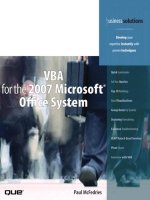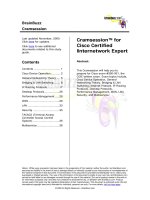Tài liệu Proposal for Fast-Tracking NIST Role-Based Access Control Standard doc
Bạn đang xem bản rút gọn của tài liệu. Xem và tải ngay bản đầy đủ của tài liệu tại đây (391.99 KB, 29 trang )
Proposal for Fast-Tracking
NIST Role-Based Access Control
Standard
David Ferraiolo
Rick Kuhn
National Institute of Standards and Technology
Gathersburg, Maryland
Ravi Sandhu
George Mason University
Fairfax, Virginia
Agenda
•
Why an RBAC Standard?
•
Is the Standard Ready to Go?
Some of the Vendors Offering
RBAC Products
Accurate Configuration
Control Over User Privileges
Lots of users and privileges scattered
over many platforms and applications.
Who are the valid users?
What are they entitled to access?
How do you keep access rights up-to-
date?
How do you specify and enforce
policy?
Maintaining Access Configurations
is Labor-Intensive
2000
2001
2002
2003
-
200
400
600
800
1,000
1,200
Year
Privileges almost double yearly
growing from less than 200k to
over 1M in 2004
Source: IDC, 2001
Resources
Users (100's of)
Privileges
(1,000's of)
Estimated Privilege distribution Activity
in Typical Companies
•
Adding IT Staff Scales
Linearly
•
Administering Privileges
Scales Non-Linearly
•
Symptoms of the problem
–
Unused accounts proliferate
–
Turn-on time rises for user privilege
creation
–
Privilege review is impractical
–
Security audits fail
–
User down-time increases
–
Security admin requests staff increases
–
Help desk requests staff increases
Manually Configuring Privileges
Organizations use
slow and
inconsistent
processes to create
user access rights
User Change
Request for
Access
Generated
Policy &
Role
Examine
d
Approval
Routing
IT InBox
Administrators
Create Accounts &
Access Rights
Users with
Accounts
Elapsed turn-on time:
up to 12 days per user
Account turn-o/
performance: 30-60%
of accounts are
invalid
RBAC Supports Front-End
Processes
Maintain who gets
what based on your
organization’s
operational policies
User Change
Request for
Access
Generated
Policy &
Role
Examine
d
Administrators
Create Accounts
Users with
Accounts
Approval
Routing
IT InBox
Installed Technology Base
Access Control List (ACL) are the most
common access control mechanism in use
today
–
Fine when end-users are viewed as “owners” of enterprise
resources
–
Resource Oriented: poorly organized to address many commercial
and Government security policies
–
Costly and difficult to centrally administrate
–
At the wrong level of abstraction
–
Platform Dependent with proprietary administrative tools
Role-Based Access Control – A Strategy for
Security Policy Management
•
Centrally administered and locally enforced role
based access control policies
•
Policy Rich: highly configurable (richer set of
parameters)
•
Enforces access control across the virtual enterprise
–
Employees
–
Suppliers
–
Consultants
•
Role membership is based on Competency, Duty,
Authority, giving the user’s the potential to execute
privileges
•
Role centric (roles are global and persistent)
Motivations
•
Simple and Intuitive Administrative Interface
•
Administrative Efficiency
–
Automatic user privilege assignment
–
Automatic revocation of user privilege
–
Simple user functional re-assignment
•
Administrative Flexibility
–
Static Separation of duty (SSD)
–
Fine granularity of resource/administration partitioning
•
Scalability, Extensibility, Accuracy
•
Agreement of core RBAC Features
•
For Each RBAC feature in the standard there
are one or more known implementations
•
Broad industry involvement in ACM RBAC
Workshops
Background
•
NIST study reviewed the access control practices of 30
large organizations
•
First RBAC model published in 1992
–
Combined several existing and emerging concepts (OS user groups, DBMS
privilege groups [Baldwin90], separation of duty [Clark-Wilson87,
Sandhu88, Brewer-Nash89] into a single relational model [Ferraiolo-
Kuhn92]
–
Reference implementation led to a revision [Ferraiolo-Cugini-Kuhn95]
•
Annual ACM RBAC Workshop series started in 1995 with
international vendor and researcher participation
•
Sandhu et al, developed a well accepted comprehensive
RBAC framework in 96
•
Sybase implemented most of NIST RBAC model in 1996,
DBMS survey showed other vendors have RBAC features
•
Based on these efforts numerous other models have
been proposed that have often included reference
implementations
Background
•
Since 1995 vendors, users, and researchers have gathered
on an annual basis to present papers and discuss issues
related to RBAC, in a formal ACM workshop setting
•
RBAC has matured to the point where it is being consistently
prescribed as a generalized approach to access control
–
“the most attractive solution for providing security in e-government”
IEEE COMPUTER, Feb. 2001
–
“most relevant in meeting complex policy needs of Web-based
applications” ACM COMMUNICATIONS, Feb. 2001
•
First effort to define a consensus standard for RBAC was
proposed in a special session at the 5
th
ACM Workshop on
RBAC
•
Published comments resulted in the existing proposed
standard
Diffusion of RBAC - 2001
42
8
12
12
27
Considering
Developing
Purchased
Using
No plans
Estimated Use of RBAC in 2005 - by
industry (mid-range est)
0
20
40
60
80
100
30
Finance &
Insurance
Health Care
Government
Edu, Prof
Services
Manufacturing
Utilities
Transportation
Timeliness & Appropriateness of RBAC
Standard
•
Need for consistent, universally
understood semantics for RBAC
•
Vendors value “establishing a taxonomy
and a shared vocabulary for us, our
customers, and the industry as a whole”
Is RBAC ready for a standard?
•
Network Applications Consortium -
$500,000,000,000 customer base says:
“If RBAC is going to ‘move to the
mainstream’, then there will have
to be some sort of standard.”
Current Situation - Problem
•
Although existing models and
implementations use similar RBAC concepts,
they differ in significant areas and use
different terminology
•
RBAC is a rich and open-ended technology,
ranging from the very simple to the complex
–
Not all features are appropriate for all environments
–
No vendors implement all RBAC features
–
Research continues to promote its use in other applications
and extended features
Solution - RBAC Standard
•
Standardization over a collection of basic and well
accepted RBAC features
•
Features are divided into logical components and
sub-components
•
Sub-components can be combined into relevant
packages giving:
–
IT consumers a basis for uniform acquisition specification and a basis for
making purchasing decisions
–
Vendors a set of benchmarks use in the characterization and marketing of
their products
•
Each feature is known to be viable in that there
exists at least one example commercial and/or
reference implementation
Standard Organization
•
Two Main Parts
RBAC Reference Models
Requirement Specification
•
Four Components
Core RBAC
Hierarchical RBAC
Limited Hierarchies
General Hierarchies
Static Separation of Duty Relations
Without Hierarchies
With Hierarchies
Dynamic Separation of Duty Relations
Conformance
•
Standard provides for conformance by
vendor self-declaration
•
Standard provides foundation for third-
party conformance testing sought by
vendors and customers
Requirement Specification
•
Requirements are specified using the
relations defined by the reference model
•
Administrative Operations
(e.g., create/delete role, create/delete user
assignment, create/delete hierarchical relation)
•
Administrative Queries and Review Functions
(e.g., assigned users, assigned roles, authorized
users, authorized permissions, separation of duty
relations)
•
System Functions
(e.g., session management, access calculation)
Core RBAC
Hier. RBAC
a. Limited
b. General
SSD Relations
a. w/hierarchies
b. wo/hierarchies
DSD Relations
R
e
q
u
i
r
e
m
e
n
t
s
P
a
c
k
a
g
e
Select Core RBAC
Option: Advanced Review
Choose a. or b
Option: Advanced Review
Adhere to dependency
Methodology for Creating
Requirement Packages
Conclusion
RBAC is ready for a standard
•
User need - $500,000,000,000 customer
base says:
“If RBAC is going to ‘move to the
mainstream’, then there will have to
be some sort of standard.” – NAC
•
Vendors - At least 28 vendors offer some
type of RBAC product
•
Future solutions - “the most attractive
solution for providing security in e-
government” IEEE COMPUTER, Feb. 2001
Additional Information on
Standard Components
•
Core RBAC
•
Hierarchical RBAC
•
Role Inheritance
•
Static Separation of Duty
•
Dynamic Separation of Duty
Core RBAC
•
Many-to-many relationship among individual users and privileges
•
Session is a mapping between a user and an activated subset of assigned roles
•
User/role relations can be defined independent of role/privilege relations
•
Privileges are system/application dependent
•
Accommodates traditional but robust group-based access control
USERS
ROLES
OPERA
TIONS
OBJECTS
privileges
(UA) User
Assignment
(PA)
Permission
Assignment
Sess-
ions
user_sessions session_roles









